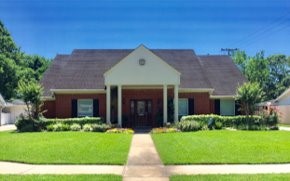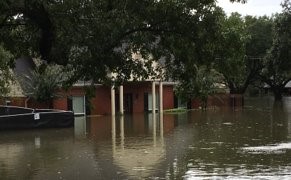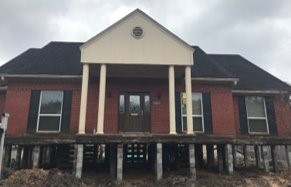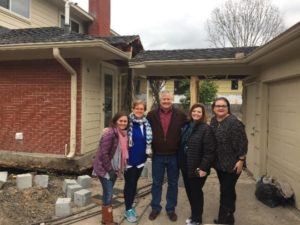29 Sep Three Feet of Water and Six Feet Up: An ADKAR® Story
Our team at Access Sciences stands by the Prosci ADKAR® Model for Change Management. Not only is it practical and intuitive, but it’s also scalable – it can be applied to personal change or a global organization with thousands of people.
My ADKAR® story falls closer to the former, impacting my family with not one, not two – but three consecutive floods.
Our team at Access Sciences stands by the Prosci ADKAR® Model for Change Management. Not only is it practical and intuitive, but it’s also scalable – it can be applied to personal change or a global organization with thousands of people.
My ADKAR® story falls closer to the former, impacting my family with not one, not two – but three consecutive floods.
AWARENESS

AWARENESS of the need for change.
DESIRE to participate and support the change.
KNOWLEDGE on how to change.
ABILITY to implement required skills and behaviors.
REINFORCEMENT to sustain the change.
AWARENESS

Our house in Houston had been our home-sweet-home, our safe-haven since 2007. It had everything a family wanted in a home – it was comfortable, had a pool, zoned to good schools, and was located near family and friends in a quiet, closed-in neighborhood. Perfect, right?
Well, almost.
In 2015, my family and I were at a Memorial Day Little League Tournament. The skies over the fields were getting dark and lightning could be seen in the distance. The tournament was cancelled, and the skies began to drop heavy amounts of rain during our drive home. The Memorial Day Flood drenched Southwest Houston by dumping 15 inches of rain in only nine hours.
When our home started taking in water, I was overcome with the feeling of helplessness. We lost belongings, some of which couldn’t be replaced. I honestly thought I had experienced the feeling of helplessness before, however, the Memorial Day Flood redefined that emotion for me forever. Our home took on eight inches of water and required three months to put it back together. After that flood, we thought it was just a freak rain event since our home had never flooded in its 54-year existence.
In 2016, the Tax Day Flood drenched our quiet neighborhood, dumping 14 inches of rain in only 12 hours. The flooding nightmare returned. Although this time, we didn’t lose many personal belongings; the damage was minor and we knew we would survive it once again. We shrugged off both floods as flukes because “improvements” were in the works for the Brays Bayou Watershed. The floods weren’t flukes – we were wrong.
If you’re a fellow Houstonian, you know exactly what devastated our city in 2017: Hurricane Harvey. Over just a couple of days, it dumped between 50 to 52 inches of rain onto the city. We assumed that we were going to flood, but I assumed that we would get approximately 18 inches in the house based on rainfall rates from the Memorial Day Flood. So we planned for 18 inches and jacked up all of our furniture on cinder blocks. I even took the time to cut plastic sheets to cover the cinder blocks so the water they absorbed wouldn’t impact the wood legs on our furniture. We moved as much furniture as possible upstairs.
Around 9 p.m. that night, the rain just fell and fell with no end in sight. By 11 p.m., the water already entered our home and was almost up to the electric outlets. My husband waded through the water and made it to the garage. He located the electrical panel and turned off all of the power to the bottom floor. He waded back into the house and the water rose about four inches in just that short of a time. We had to ensure everyone would be safe and comfortable upstairs because we knew that would be our living quarters for the next couple of days.

We knew the bayous had breached and we were in for a long, sleepless night. By midnight, you could hear furniture crashing downstairs. Water had taken over our home once again. At one point, we made a mark on the sheetrock on the staircase to see if the water was going up or down as it was hard to tell in the middle of the night.
After the storm passed, my family and I were left with three feet of water surrounding our once comfortable home. Out the upstairs window, we could see Coast Guard Helicopters rescuing people by plucking them out of the water. Boats were traveling along the major boulevards in my neighborhood. This was all so eerie. Even though we were surrounded by water, we were at least safe upstairs. We still had electricity, but no air conditioning as the outside units were under water.
By the next day, we went downstairs to evaluate the damage. Everything from four feet and below was ruined. Our once beautiful home was water logged once again. This time, it was four times as worse as the Memorial Day Flood. I felt like a professional at that time. I called the insurance company to file a claim. I called a trash company to have a 50-yard dumpster delivered so we could begin to throw out our belongings. I called our moving and storage vendor and asked them to reserve space for me. What we could save, we packed up and moved out of the house so we could setup living quarters for my family of three and the family cat. Once again, it was back to the drawing board. Demo began right away and this time, we even had a couple of strangers help us with the rip out. The community came together.
We had to figure out what to do to get back on our feet. We were able to put the house back together within three and a half months. We knew we had to do something to prevent the flooding and the only way was to elevate. I found myself going through the ADKAR® model to guide us through this process. I didn’t realize that I was taking that approach, but in hindsight, it truly helped to define our path to mitigate future flooding.
DESIRE
Before Hurricane Harvey hit, we saw that several homes in our neighborhood were elevated or in the process of being elevated. It amazed me that a cement slab foundation could be elevated off of the ground from one to ten feet. After Harvey (and seeing that the preceding floods were, in fact, not flukes), we clearly had a desire to learn more about home elevation to save our house from future floods.
KNOWLEDGE
Since flooding was becoming an annual occurrence, we started to research the elevation process. We went to seminars, talked to neighbors and friends about the process, and ultimately determined that home elevation was the best solution since selling for lot value or tearing down and rebuilding were not options for us.
We had invested a lot of cash equity into our home when we purchased it in 2007, and I didn’t want to walk away with a loss. Some people did, but as a business person, I didn’t think that was the best choice at the time.
We explored more about the elevation process – how long it took to elevate, the overall project costs, and explored ways to fund the project. This entire process was so new to our neighborhood, a neighbor setup a Facebook Group so we could exchange our experiences.
ABILITY
After three floods in the timespan of three years, our home was marked as a Repetitive Loss (RL) property. Because of this, we were fortunate to work with the Small Business Administration (SBA) to obtain a Disaster Loan to help finance the process of elevating our home six feet off the ground and out of the flood plain. The SBA gave us hope that we could return to a somewhat normal life. It was similar to a second mortgage, but I figured the value of our home would eventually go back up once the house was up and out of harm’s way.
We selected an elevation company, and we were in the first wave of homes to be elevated. They starting digging in mid-January, just after a brief snow storm. It took them two and a half weeks to dig all of the tunnels necessary to press the 97 piers into the ground that would eventually suspend our house in the air.
On February 2nd and 3rd, our home was elevated six feet and one inch off the ground. We were finally above the 500-year flood plain. If our house ever flooded again, the rest of Houston would be in trouble.

REINFORCEMENT
My colleagues cheered me on for those two days. They visited the worksite, brought meals, and even filmed the whole event with a time lapse camera. Everyone was so amazed that a concrete slab house could be elevated to those heights.

Two years after Hurricane Harvey, our home is put back together with an increased chance of surviving another major flood event. As we embark on this year’s hurricane season, seeing the new version of our home-sweet-home, our safe-haven every day reinforces the fact that we successfully mitigated future flooding.

Hurricane Harvey was a big wake-up call, and I (along with many others in the area) became aware that something needed to change to lessen future flood damage. We desired a solution to help us achieve that, which ended up being home elevation. We sought knowledge on the process – how long it would take, how much it would cost, etc. And then, we gained the ability to do so by obtaining resources needed to embark on the project. Now, we’re able to enter the next hurricane season without the constant stress of possibly losing our home, which just reinforces our decision to make the change.
Anyone who’s experienced a life-change can relate to the Prosci ADKAR® Model. It works for navigating personal change, and it works for navigating organization-wide change. And that’s why our team at Access Sciences stands by the ADKAR® Model.



